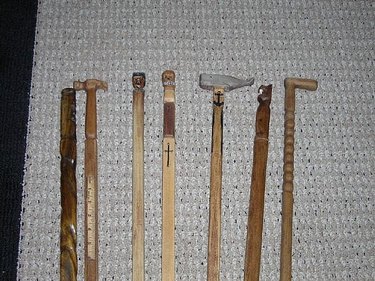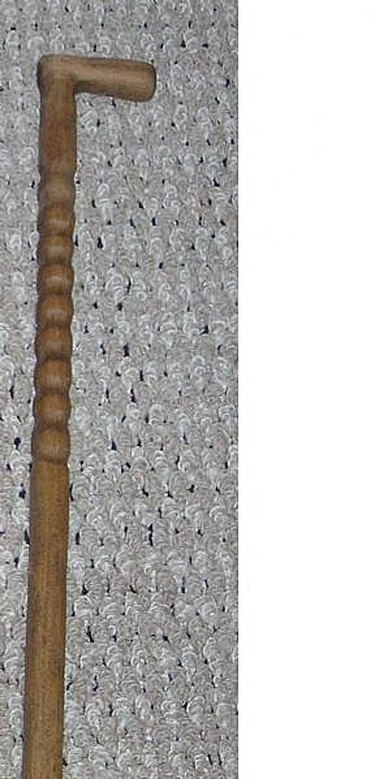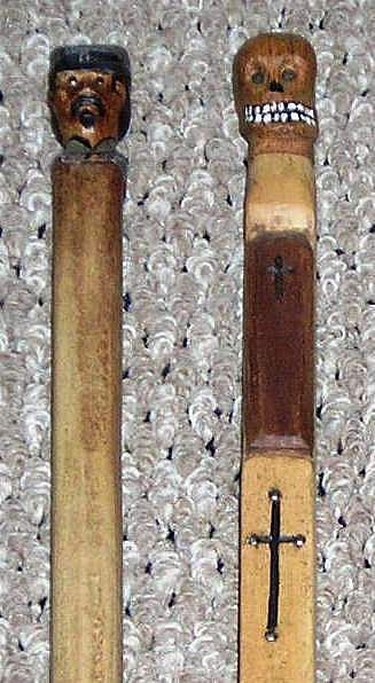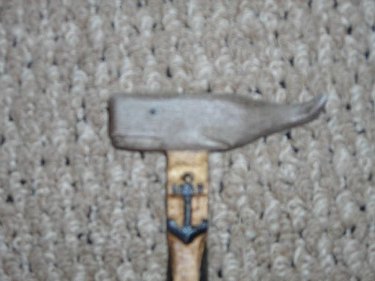Things You'll Need
hardwood lumber
carving knives
sand paper
pencil
wood stain, shoe polish, varnish or sealer
Metal nail or rubber cap
optional: acrylic or oil paints

Walking canes have been around since the first man injured his or her foot or leg. Probably just a heavy stick. I hope to give you some pointers on making hand carved canes. (walking sticks have a tendency to be more natural and primitive.
Making good canes takes practice in the art of carving, wood finishing and wood working.
Video of the Day
Step 1

Basic cane construction: Canes can be made just as art or for use. If as art, the strength is not very important. I prefer to make mine to be used as well as art. So the use of hardwoods like oak, beach, maple or other woods are recommended.
You can get wood from the wild but a branch should be cut over sized, cut green and put up out of the sunlight for several months to dry before carving.
I get most of my wood already seasoned from a local cabinet shop that gives me hardwood pieces for free, their scrap.
Step 2

The cane shaft: Canes come in all manner of design and construction. The shaft can be turned round on a lathe or kept square, or rounded with a knife or carved with a twist. The wood you use, the pattern in the wood or grain will help determine what you want to do. It is up to you. Just ensure that the cane is strong enough after carving to bear an adult's weight without bending or breaking.
Step 3

Straight canes can be carved with a wide variety of grips. The photo shows a soldier cane and a "Day of the Dead" cane. I have also made canes with a cat's head, wizard, ball, dragon. Oil or acrylic paints can be used as well as wood stains and shoe polish to add some color to your work.
Step 4

My canes are at least 1 1/4" in diameter when finished.
Consider engraving names, figures, inlays or decorative carvings in the shaft. The carpenter's Cane at the illustration has a ruler inset into the shaft.
Sand smooth with sandpaper when satisfied.
Step 5

Adding a decrative hand grip: A large horizontal hand grip can be added to your cane shaft by inserting a dowel rod into the shaft and the grip and glueing them together with carpenter's wood glue. These should be firmly clamped with wood clamps to dry over night. If you can't use wood clamps try blue painter's tape and tape them tightly and let dry.
Step 6

Finishing: Make certain your cane is well sanded, and clean of dust before painting, staining or varnishing. Acrylic paints, oil paints, shoe polish and wood stains can be used on your cane. When finished a good varnish will protect your work, follow the instructions on the can.
After drying your cane can be polished with furniture wax and buffed with a clean cotton rag.
Step 7

A nail can be added to the bottom of your cane to prevent wear to the wood. Drill a hole smaller than the diameter of a broad headed galvenized nail. Hammer the nail into the bottom of the cane shaft so it is almost flush. (drilling a hole first prevents your shaft from splitting)
Tip
Take your time try different designs Cabinet shops often have hardwood, sometimes exotic woods for making canes Be imaginative
Warning
Use varnishes and wood stains in a well ventilated location Use a tack cloth and paint, stain and varnish in a clean area to prevent dust from ruining your work. Never let children use power tools or sharp knives unsupervised.
Video of the Day